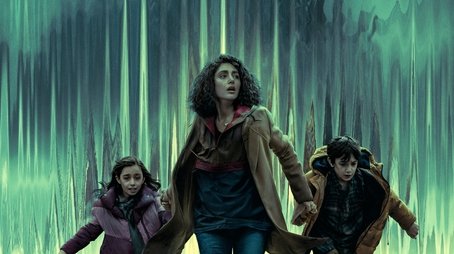
Ask Your Own Question
What is the plot?
The episode opens with a festive atmosphere in Springfield as the holiday season approaches. The Simpson family is excitedly preparing for Christmas, and Marge is particularly enthusiastic about the decorations. She hangs up a large Christmas wreath on the front door, while Homer is more focused on indulging in holiday treats. The family gathers around the television to watch a classic Christmas special, which sets the tone for the holiday spirit.
As the episode progresses, Homer becomes increasingly nostalgic about the Christmas specials he watched as a child. He reminisces about the magic of those shows and expresses a desire to recreate that feeling for his family. Inspired, he decides to produce his own Christmas special, believing it will bring the family closer together and capture the essence of the holiday season.
Homer's enthusiasm leads him to enlist the help of his family. He pitches the idea to Marge, Lisa, Bart, and Maggie, who are initially skeptical but eventually agree to participate. They brainstorm ideas for the special, leading to a series of humorous and chaotic moments as they try to come up with a storyline. Each family member contributes their own unique ideas, resulting in a mishmash of concepts that reflect their individual personalities.
As they begin filming, the process proves to be more challenging than anticipated. Homer struggles with directing and managing the various personalities involved, leading to conflicts and misunderstandings among the family members. Tensions rise as they face creative differences, and Homer's frustration grows when things don't go as planned. Despite the setbacks, the family perseveres, driven by their desire to create something special together.
In a pivotal moment, Homer realizes that the heart of the Christmas special should focus on the importance of family and togetherness rather than just flashy production values. This revelation helps him reconnect with his family, and they come together to refocus their efforts. They decide to incorporate their personal experiences and memories into the special, making it more meaningful.
As the filming continues, the family faces various comedic obstacles, including mishaps with props and unexpected interruptions. However, these challenges ultimately bring them closer together, reinforcing the bond they share. The atmosphere becomes more lighthearted, and they begin to enjoy the creative process, laughing and supporting one another.
The climax of the episode occurs when they finally complete the Christmas special. The family gathers to watch the finished product, filled with anticipation and excitement. As they view the special, they reflect on the journey they took to create it, realizing that the experience itself was more valuable than the final product. The emotional moments resonate with each family member, highlighting their growth and unity.
In the closing scenes, the Simpson family shares a heartfelt moment, appreciating the time spent together during the project. They embrace the spirit of the season, recognizing that the true meaning of Christmas lies in their love for one another. The episode concludes with a warm and festive atmosphere, leaving the audience with a sense of joy and togetherness.
What is the ending?
In the ending of "'Tis the 30th Season," the Simpson family, after a series of misadventures and a Halloween-themed journey, finds themselves in a precarious situation. Homer, Marge, Bart, Lisa, and Maggie come together to confront the chaos that has unfolded. Ultimately, they manage to restore order and celebrate their unity as a family, embracing the spirit of Halloween and the importance of sticking together.
As the episode draws to a close, the family reflects on their experiences, and they share a heartfelt moment that reinforces their bond. The episode ends with a classic Halloween twist, leaving the audience with a mix of humor and warmth.
Now, let's delve into the ending in a more detailed, chronological narrative.
The climax of the episode unfolds as the Simpson family faces the consequences of their Halloween escapades. After a series of spooky events, including encounters with various Halloween-themed characters and situations, the family finds themselves in a haunted house that has become a central point of conflict. The atmosphere is thick with tension, and the eerie decorations and dim lighting create a sense of urgency.
Homer, feeling the weight of responsibility, rallies his family together. He expresses his desire to protect them, showcasing his deep-seated love and commitment as a father. Marge, ever the supportive wife, encourages Homer, reminding him of their strength as a family. Bart, Lisa, and Maggie, each displaying their unique personalities, contribute to the plan to escape the haunted house. Bart's mischievous nature leads to some humorous moments, while Lisa's intelligence shines as she devises a strategy to navigate the spooky challenges ahead.
As they work together, the family encounters various obstacles, including ghostly apparitions and traps set within the haunted house. Each character faces their fears, with Bart confronting his tendency to act recklessly, Lisa grappling with her anxiety about the unknown, and Maggie showcasing her bravery despite her young age. The emotional stakes rise as they realize that their only way out is to rely on one another.
In a pivotal scene, the family reaches a moment of crisis where they must confront a particularly menacing figure that embodies their fears. It is here that they come together, using their individual strengths to overcome the threat. The scene is filled with tension, but also a sense of camaraderie as they support each other, showcasing the theme of family unity.
As they finally escape the haunted house, the family emerges into the light, symbolizing their triumph over fear and adversity. They share a moment of relief and joy, realizing that their bond has grown stronger through the challenges they faced. The emotional weight of their journey culminates in a heartfelt exchange, where they express gratitude for one another, reinforcing the importance of family.
The episode concludes with a classic Halloween twist, as the family returns home, only to find that the spooky elements of their adventure have followed them back. This final moment serves as a humorous reminder of the Halloween spirit, leaving the audience with a blend of laughter and warmth.
In summary, the ending of "'Tis the 30th Season" encapsulates the essence of the Simpson family's journey, highlighting their resilience, love, and the importance of facing fears together. Each character emerges from the experience with a renewed sense of connection, showcasing the enduring theme of family in the face of adversity.
Is there a post-credit scene?
In the episode "'Tis the 30th Season" from Season 30 of The Simpsons, there is indeed a post-credit scene. After the main story concludes, the scene features a humorous moment that plays on the holiday theme of the episode.
In this brief segment, we see a festive setting where the characters are engaging in a light-hearted activity. The scene captures the spirit of the season, showcasing the family dynamics and the comedic interactions that are characteristic of The Simpsons. The post-credit scene serves as a playful wrap-up, leaving viewers with a smile as they reflect on the episode's themes of nostalgia and holiday cheer.
This moment encapsulates the essence of the show, blending humor with the warmth of family togetherness, and it reinforces the ongoing tradition of including fun, additional content after the main credits.
What is the significance of the Halloween special in this episode?
In 'Tis the 30th Season,' the Halloween special serves as a nostalgic callback to the show's long history of Treehouse of Horror segments. It highlights the characters' fears and desires, particularly Homer, who grapples with the passage of time and his legacy as a father. The special is a blend of humor and horror, showcasing the show's signature style while also reflecting on its 30-year legacy.
How does Homer feel about turning 30 years old in this episode?
Homer experiences a mix of anxiety and nostalgia about turning 30. He reflects on his life choices and the passage of time, feeling a sense of urgency to make the most of his remaining years. This internal conflict drives much of his behavior throughout the episode, as he seeks to reclaim his youth and prove that he can still be relevant.
What role do Marge and the kids play in Homer's journey during this episode?
Marge and the kids serve as both a support system and a source of conflict for Homer. They encourage him to embrace his age and the wisdom that comes with it, while also challenging his desire to relive his youth. Their interactions highlight the importance of family and the different perspectives each member has on aging and legacy.
How does the episode incorporate references to past seasons of The Simpsons?
The episode is rich with references to previous seasons, including callbacks to iconic moments and characters from the show's history. These references serve to create a sense of continuity and nostalgia, reminding viewers of the show's evolution over the years. They also enhance the emotional weight of Homer's journey as he reflects on his past.
What is the climax of Homer's realization about aging in this episode?
The climax occurs when Homer confronts the reality of his age and the impact it has on his family. He realizes that while he may not be able to reclaim his youth, he can still create meaningful memories with his loved ones. This moment of clarity leads to a heartfelt resolution, where he embraces his role as a father and the joys of growing older.
Is this family friendly?
In the episode "'Tis the 30th Season" from Season 30 of The Simpsons, there are a few elements that may be considered objectionable or upsetting for children or sensitive viewers:
-
Dark Humor: The episode features themes of horror and dark comedy, which may not be suitable for younger audiences. The tone can be unsettling at times.
-
Violence: There are scenes that include cartoonish violence, typical of The Simpsons, but some moments may be more intense or graphic than usual.
-
Scary Imagery: The episode includes visual elements that are designed to be spooky or frightening, which could be distressing for younger viewers.
-
Mature Themes: There are references to adult themes and situations that may not be appropriate for children, including discussions about mortality and existential dread.
-
Sarcasm and Irony: The use of sarcasm and ironic humor may go over the heads of younger viewers, potentially leading to confusion about the intended message.
Overall, while The Simpsons is known for its humor, this particular episode contains elements that could be considered more suitable for older children and adults.











